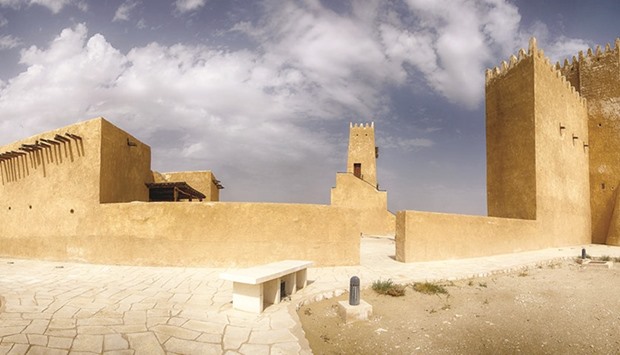In the midst of Eid festivities, exploring the cultural side of Qatar should fit just right in your outdoor activity plans. With its Self-Guided Tours – Spring 2016, Qatar Museums (QM) urges you to take few hours out to “experience some of the most interesting historical places and art scenes in the country” this summer.
In its tailor-made programme for those keen on savouring some of the finest historical places and exhibitions in Qatar, QM’s self-guided itineraries vary in length, allowing you to choose an experience that will fit your schedule. In its detailed tour guide notes, QM points out, “Our public art enrich public spaces and play an important role in bringing art to the community’s everyday life.” The itinerary includes highlights of important pieces, so you can choose which ones to see or spend a full day exploring them all.
The first recommended stop is Richard Serra’s East-West/West-East installation, to reach which a 4WD is required. Consisting of four plates that are about 49 feet tall, the installation stands tall near Zekreet, 60kms outside Doha. The awe-inspiring standing-plate work spans over a kilometre in length, and crosses the peninsula of the Brouq Nature Reserve, connecting the waters of the Gulf.
The second stop recommended is Perceval by Sarah Lucas at Aspire Park. An admirable slice of British culture, Perceval is a bronze sculpture of a shire horse. At 2.3 meters tall by 4 meters long, it is life-size. The horse leads a cart containing giant marrows, cast in cement to contrast with the finish of the painted bronze, and blends in beautifully at what is Qatar’s biggest park, covering an area of 88 hectares.
Stop number three is for another Serra work. Titled 7, Serra’s heptagonal sculpture is made of seven steel beams, erected at the end of Museum of Islamic Art Park, facing the sea. At 80 feet high, it is the tallest public art piece in Qatar and the experience of standing inside it is not to be missed.
Stop number four is Gandhi’s Three Monkeys presented as a bronze installation by Indian artist Subodh Gupta at Katara. The piece pays homage to Gandhi’s famous ‘see no evil, hear no evil, speak no evil’ dictum.
For a two-hour tour, QM recommends sifting through Mathaf: Arab Museum of Modern Art, which also includes Focus: Works from Mathaf Collection (Part 2) that is on until September 1. While Mathaf is closed on Monday, it is open Tuesday to Thursday from 11am to 6pm; Friday 3pm to 8pm; and Saturday and Sunday 11am to 6pm. “Mathaf houses a unique collection of modern and contemporary art from the Arab world. Get to know the Arab artists of our time by visiting Focus: Works from Mathaf Collection, an on-going series of solo exhibitions featuring Arab artists from the museum’s permanent collection. Once you are done, take a break at the museum’s café and gift shop,” the QM says, in its note on the tour.
As for reaching Mathaf, you can hop on the Mathaf Bus. A free shuttle service that connects Mathaf to the Museum of Islamic Art, it operates every Wednesday to Sunday from 11am to 5pm. Some of the other recommendations include visiting the Museum of Islamic Art, and also the QM Gallery Al Riwaq, where you can catch the spectacular ‘What About the Art? Contemporary Art from China’ exhibition, featuring the works of 15 Chinese artists, which is on till July 16.
For the big six-hour tour, step back in time by driving down to Madinat Al Shamal and revelling in the glory of Al Zubarah Archaeological Site, or going to Umm Salal Mohammed to take in the beauty of Barzan Towers – both places are open from 9am to 5pm.
“Across Qatar there are many heritage sites that show the richness and value of Qatari history and tradition. Step out of urban Doha and head north to explore the Al Zubarah Archaeological Site, an old pearl-diving town and Qatar’s first Unesco World Heritage Site,” QM explains, “On the way back to the city, stop by Barzan Towers, two restored watchtowers from the 19th century that really represent the unique architecture style of the Arabian Gulf.”

HISTORICAL: Barzan Towers.
